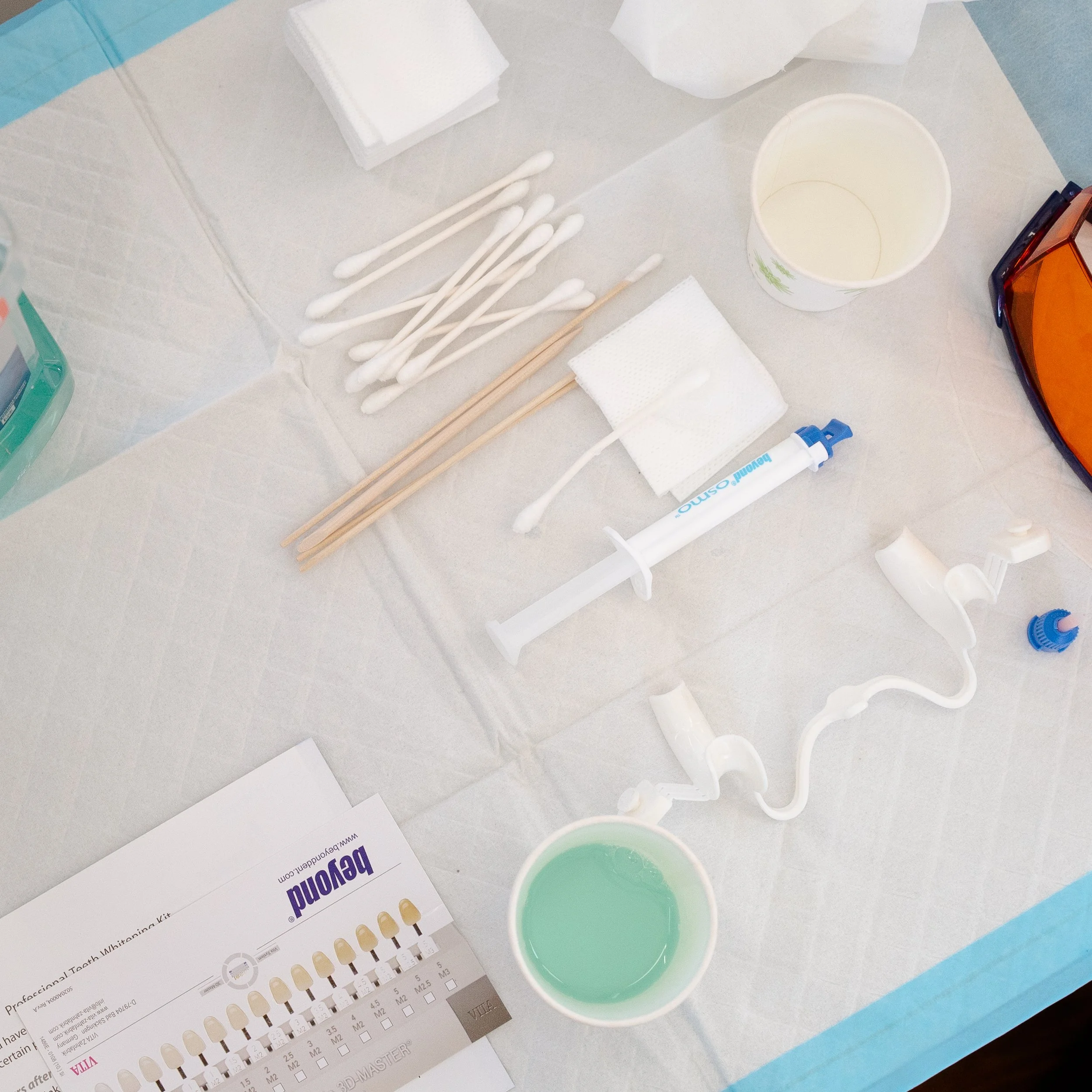
SERVICES
Teeth Whitening
Illuminate your smile with professional teeth whitening.
Your smile is one of the first things people notice about you, so why not take care of it? External Affairs is proud to offer professional teeth whitening treatments to help your pearly whites sparkle - for up to 12 months!
Superior whitening for a confident, beautiful smile!
Using a combination of concentrated blue LED light and proprietary whitening gel formula, our teeth whitening procedure effectively break-ups stains and returns your smile to its natural whiteness. Compared to over-the-counter whitening strips, our advanced whitening procedure is more powerful and offers longer-lasting, more visible results.
BEFORE + AFTER
Superior whitening for a confident, beautiful smile!
Using a combination of concentrated blue LED light and proprietary whitening gel formula, our teeth whitening procedure effectively break-ups stains and returns your smile to its natural whiteness.
Compared to over-the-counter whitening strips, our advanced whitening procedure is more powerful and offers longer-lasting, more visible results.
What to Expect
During your treatment, we take great care to isolate your mouth, so only the teeth are exposed. Our whitening gel, containing hydrogen peroxide, silicon dioxide, and other special ingredients is applied. An activation lamp is then used that emits a blue light that triggers the gel, allowing it to enter your enamel and lift the stains.

“Staff are always friendly and professional. I’ve had a great experience at both locations. They truly care about their clients!”
Teeth Whitening FAQs
-
Teeth whitening is available at our Edmonton and St. Albert clinics!
-
The entire treatment takes approximately 1 hour.
-
A follow up appointment is not necessary. If you are wanting to see dramatic whitening results in a short amount of time, you can come back after about 2 weeks for an additional treatment, however this will cause increased sensitivity.
-
In most cases, you should see whitening results lasting for up to 12 months.
-
Tooth color is influenced by a combination of organic and inorganic stains found on the surface and inside the teeth. These discolorations can be the result of several factors, including diet (drinking coffee, tea, or wed wine), lifestyle choices (smoking), age, or exposure to certain medications (such as tetracycline or fluoride).
Tooth whitening is the process of breaking apart chemical bonds in these organic and inorganic stain-causing compounds through the application of a peroxide-based whitening gel to the teeth. During the treatment, the combination of hydrogen peroxide gel and intense halogen light source oxides rapidly the organic discolorations found on the surface and inside the teeth, rendering those stains neutral in color and resulting in a brighter appearance.
This treatment is not intended to lighten artificial teeth, caps, crowns, veneers or porcelain, composite or other restorative materials. People with darkly stained yellow or yellow-brown teeth frequently achieve better results than people with gray or bluish-gray teeth. Teeth with multiple colorations, bands, splotches or spots due to tetracycline or fluorosis may have less dramatic whitening results.
Fluoride Stains
Although the whitening treatment will reduce the appearance of fluoride stains on the teeth, teeth whitening cannot actually remove the stains. The purpose of the treatment will be to whiten the surrounding enamel, thereby reducing the appearance of the fluoride stains. Immediately following treatment, the stains may appear whiter, but that will rebound quickly over the next 24 hours and the difference between the fluoride stains and the enamel will be less obvious within 24-48 hours following the treatment. -
For the first 24 hours after the treatment, a "white diet" is recommended. You should avoid using tobacco products and consuming coffee, tea, red wine and other dark-colored foods and drinks. Avoid using colored mouthwashes or toothpastes as well.
After the treatment, it is natural for the teeth to regress somewhat in shading over time. This is normal and should be very gradual, but it can be accelerated by exposing teeth to various staining agents.
Tips for maintaining your newly whitened teeth include:
Avoiding the consumption of or exposure to products that stain your teeth (see first question on what causes teeth to become stained). If you do choose to consume beverages that stain, consider using a straw so that the liquid bypasses your front teeth.
Brush or rinse immediately after consuming stain-causing beverages or foods.
Follow good oral hygiene practices. Brush your teeth at least twice daily and floss at least once daily to remove plaque.
Use a whitening toothpaste (once or twice a week only) to remove surface stains and prevent yellowing. Use a regular toothpaste the rest of the time.
-
Possible risks include, but are not limited to:
Tooth sensitivity - During the first 24 hours after treatment, some can experience slight tooth sensitivity. While uncommon with this system, tooth sensitivity can be a side effect of peroxide-based tooth whitening. It is usually mild, but can be worse in susceptible individuals. Normally, tooth sensitivity following the use of peroxide-based whitening products subsides within 24 hours. People with existing sensitivity, recently cracked teeth, ab-fractions (micro-cracks), open cavities, leak fillings, or other dental conditions that cause sensitivity may find that those conditions increase or prolong tooth sensitivity after the treatment.
Gum irritation - in rare cases, whitening gel may come in contact with the gum tissue during the treatment and may cause inflammation or whitening of the gums or gum line.This is due to inadvertent exposure of a small area of those tissues to the whitening gel and the inflammation and/or whitening is usually temporary and will subside almost immediately, with color change in the gum tissue reversing within 30 minutes.
Dry Lips - You may have dryness of chapping of the lips afterwards due to your mouth being kept continuously open for the treatment by a plastic retractor. This can be treated by the application of lip balm, petroleum jelly, or Vitamin E cream.
This treatment is not recommended for pregnant or nursing women, clients under the age of 16 years, or clients with little or no tooth enamel.
If you have inflamed or swollen gums, you should talk to your dentist before undergoing the treatment. This is an indication of a more serious oral health issue and should be treated beforehand. If you have broken teeth or visible cavities, you should also talk to your dentist prior to treatment.
-
Teeth whiteners do not damage tooth enamel. Enamel is considered the hardest tissue in the human body, and consists of tiny tubules that can only be viewed under a microscope. While enamel is the outermost layer of the tooth, dentin, the layer of tissue beneath the enamel, absorbs the majority of the stain. During the whitening process, the product flows through the enamel tubules and starts lightening the underlying stained tissue. After treatment, these tubules are left open and exposed, known as dehydration, but are quickly remineralized by organic matter found in saliva.
-
This treatment is not recommended for pregnant or nursing women, clients under the age of 16 years, or clients with little or no tooth enamel.
If you have inflamed or swollen gums, you should talk to your dentist before undergoing the treatment. This is an indication of a more serious oral health issue and should be treated beforehand. If you have broken teeth or visible cavities, you should also talk to your dentist prior to treatment.
-
The treatment generally does not hurt, however if you know you are prone to having tooth sensitivity, you can take an over-the-counter analgesic (i.e. Ibuprofen or Tylenol) prior to treatment. It is recommended to avoid any extremely hot or cold foods for the next 24 hours.






